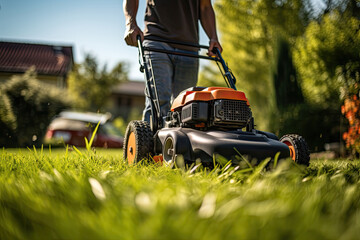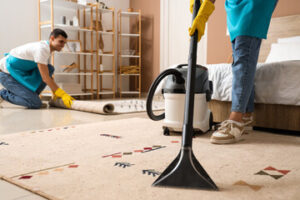Cabinet Refinishing San Jose CA is an effective way to give your cabinets a major visual upgrade, but it has limitations. It works only on the surface of existing wood or Rigid ThermoFoil doors, and it can’t change their style profile or color.

Refinishing is messy and smelly and involves sanding and spray painting. It’s also time-consuming.
Cabinet refinishing is one of the most cost-effective renovation steps you can take to improve your kitchen. You can choose a dark stain or a bright paint, giving your home a fresh new look without the expense and mess of tearing out old cabinets and installing new ones. It also saves you the stress of planning a major kitchen remodel. You can even refinish your cabinets after you’ve done other projects in the room, making it easy to update your style over time.
If you choose to refinish your cabinets, it’s important to hire a reputable company that uses high-quality materials. This ensures that the job is done right, and will stand up to years of use. A refinishing project will require the use of chemicals, strippers, and a lot of sanding to remove the existing finish from your cabinets. It may also take longer than painting. In addition, if your cabinets have any intricate trim or carvings on the doors and drawer fronts, it will be more difficult to refinish them than other styles.
A refinishing job will not address any structural issues with your cabinets, and is only a cosmetic improvement. It’s the best option if your cabinets are in good shape, but have a dull or outdated color. However, it’s not the best choice if you have deep scratches or dents on your cabinetry. It’s also not the right choice if you want to change the color of your cabinets from a light shade to a darker one, as it can be difficult to achieve a smooth and even finish.
Replacing your cabinets is expensive and messy, causing significant disruption to your home life and lifestyle while it’s being completed. A refacing job is a better solution to this problem, but it’s still more expensive than refinishing. A refacing job will also cause more disruption to your home, as it requires the removal of the existing hardware and hinges, and will involve cutting and sanding. However, it will provide a durable new finish that is more resistant to wear and tear than paint.
Eco-Friendly
In a world where sustainability is becoming increasingly important, many homeowners seek eco-friendly home improvement options that won’t negatively impact the environment. Cabinet refinishing is one such option, as it uses the existing cabinet structure to provide a fresh new look with less environmental impact than replacing cabinets. Replacing cabinets involves a lot of waste and requires the use of new materials, which can generate a significant amount of energy in both production and transportation. Choosing to reface instead of replacing also helps reduce the amount of waste and cuts down on energy usage.
Refinishing your cabinets is an eco-friendly renovation choice because it uses fewer resources and reduces the use of chemicals that can be harmful to both humans and the environment. Traditional oil-based refinishing products release VOCs, or volatile organic compounds, which can emit toxic fumes into the air over time and are linked to a variety of negative health outcomes. Using low-VOC refinishing products like those offered by N-Hance eliminates this problem and prevents toxic fumes from lingering in your home for months after your renovation project is finished.
Choosing eco-friendly wood veneers is another way you can go green during your kitchen renovation. Repurposed timber reduces the need for fresh-cut lumber, which is a major contributor to deforestation and climate change. Alternatively, you can opt for natural woods such as beeswax or linseed oil to seal your cabinets, which minimizes off-gassing and promotes healthier indoor air quality. Lastly, you can opt for energy-efficient LED lighting to reduce your electrical consumption and lower your energy bill.
While refinishing is an environmentally-friendly alternative to replacing cabinetry, it’s not the ideal solution if your cabinet boxes are damaged or the hinges are broken. Refinishing will only address cosmetic issues such as scratches, dents and faded colors and won’t fix structural problems. In these cases, refacing is a better option since it will help you save on energy and resource consumption while giving your kitchen a more complete makeover.
Easy to Do
Cabinet refinishing is an affordable and do-it-yourself (DIY) project that can dramatically change the look of your kitchen. It’s a great option for those with older, high-quality cabinets that are still in good condition. However, it’s important to note that refinishing only covers the exterior of your cabinet boxes and won’t fix issues such as sagging doors or broken hinges. If you need to fix these problems, consider replacing the cabinets instead of refinishing them.
To refinish your cabinets, you’ll need to prepare the surface first. This includes sanding, cleaning, and priming. It’s also a good idea to remove any hardware from your cabinets before starting the refinishing process. Once you’ve prepared the surface, it’s time to apply the first coat of paint. Using a mini roller and a foam brush will help you achieve a smooth finish. Be sure to wait 4 hours for the first coat to dry before applying the second.
After the final coat of paint has dried, you can install your cabinet hardware. You can use a screwdriver to do this, or you can simply use your hands. Once you’re finished, you can enjoy your new kitchen!
Another cost-effective cabinet remodeling option is to stain your cabinets. This is a popular choice for homeowners who want a darker color for their cabinets. Staining your cabinets can also protect them from stains and scratches, so it’s a smart way to extend the life of your cabinetry.
The process of staining is a little more extensive than refinishing, but it’s worth the extra effort for those who prefer a darker, richer color for their cabinets. To stain your cabinets, you’ll need to sand the cabinet boxes, apply wood filler, and sand again before applying the stain. You’ll also need to apply several coats of stain and sand lightly between each application.
Refacing your cabinets is more extensive than refinishing, but the results are dramatic and long-lasting. It’s a great option for homeowners who have a vision for their new kitchen and are willing to put in the work. Refacing can transform the entire look of your kitchen, and it often inspires homeowners to rethink other kitchen elements, such as countertops and hardware.
Time-Saving
Refinishing is a much faster option than replacing cabinets. Cabinet replacement is often a weeks-long project, while refinishing can be completed in a much shorter timeframe. This allows homeowners to keep their kitchen functional during the renovation process. It also means less disruption to the home and family life.
Cabinet refinishing is also environmentally friendly. It preserves your existing cabinets and prevents them from ending up in landfills. This is especially important in today’s environmentally conscious world. Refinishing is also cheaper than purchasing new cabinets, so you can use the money saved to pay for other renovation steps.
During the refinishing process, the old finish on your cabinets is stripped using chemical strippers and then sanded down for a smooth surface. This process takes a lot of work and can be difficult to do without proper ventilation. This is why it’s a good idea to hire professional painters to do the job. This will protect you from harmful fumes and ensure that the job is done correctly.
Paint is a great way to elevate the look of your cabinets. It can also help them resist scratches and dents. It’s important to choose the right paint for your needs, as there are many different types of finishes available. For example, gloss paint is more durable than matte or satin finishes. A glossy finish also reflects more light, which can make your cabinets appear brighter and larger.
Another benefit of cabinet refinishing is that it can improve your home’s value. If your cabinets are outdated or worn, refinishing them will give them a fresh and updated look that will impress buyers. This can increase the resale value of your home and make it more attractive to prospective buyers.
Refinishing is a great way to give your home a facelift without breaking the bank. It’s also a time-consuming task, so it’s important to plan ahead and set aside plenty of time. It’s also a good idea to work with professionals who can handle the job efficiently and get it done in a timely manner. This will ensure that you get the best results and the highest return on your investment.

